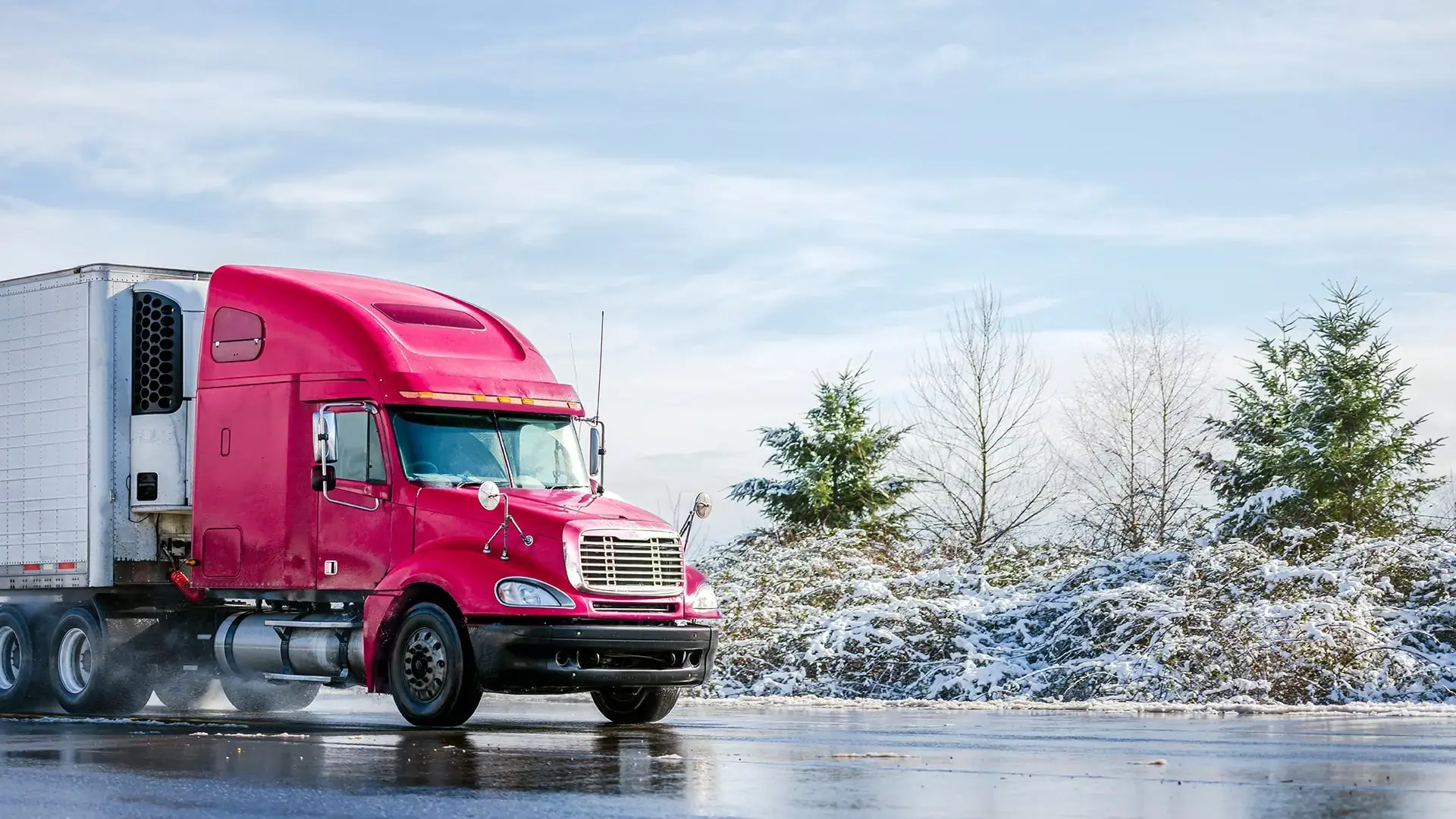Avoiding trucking accidents in the winter is a top priority for all truckers, their employers, and the public.
While it may be impossible to staff an entire fleet with seasoned million mile drivers, there are some common mistakes new drivers make that can be easily trained for and avoided, especially in the winter.
Mistake #1: Driving the Truck Like a Car
This mistake isn’t restricted to winter driving, but that’s when it can have the most serious consequences. Most experienced drivers will know instinctively how long their car takes to stop; how fast it can accelerate; and how much to turn the wheel when going around a corner.
Semi-trucks are very different from cars, taking over three times as long to stop and accelerate, and requiring more space to navigate a corner. A driver accustomed to a two-second following distance in a car will need to make a conscious effort to increase that to a six-second following distance when learning to drive a truck.
While Ontario drivers undergo mandatory training of 103.5 hours before being allowed to pass the licensing test, it still may not be enough time to fully understand the stopping distances under all conditions they will face on the job.
Many safety-focused companies go beyond the legal minimums, and require new drivers to be accompanied by experienced ones for a few months in order to correct bad driving behaviour when necessary. This allows for good driving habits to develop, such as leaving enough space to stop safely behind other drivers in all driving conditions.
Mistake #2: Inadequate Tire Pressure
As most car drivers know, winters in Canada make for challenging road conditions. Winter brings even more challenges for big trucks, and so it’s extremely important that truck drivers are properly trained for safe winter operation.
Simple things like checking your tire pressure are important when driving a truck, and winter makes this even more so in winter, as long haul trucks can be exposed to drastic temperature changes.
When a driver is in the southern US in January, the temperature might be 30°C, and in 2 days they can be back in Canada where the it’s -30°C. This is a 60 degree swing in temperature, and can impact tire pressure by as much as 10 psi. A reduction of 10 psi can make the difference between a safely inflated tire, and an under-inflated tire.
It’s therefore imperative that drivers get in the habit of checking tire pressure on a daily basis to ensure proper handling and reduce the risk of a blow out.
Mistake #3: Driving Like It’s Summer Time
Ontario has made excellent progress in trucking safety compared with other provinces by introducing mandatory driver training. However, it is possible for a driver to undergo all necessary training during the summer months when the roads are clear. Once winter comes, drivers who have been operating safely for the past six months are essentially now inexperienced drivers once again.
Winter conditions bring slippery roads that must be travelled with care. Jackknifing, where the trailer swings around to the side of the truck, is a common occurance on slippery roads, and is preventable with proper driver training. Oftentimes, trucks jackknife when the driver is braking too hard because of not leaving enough space to stop safely at a certain speed. To avoid this it’s important for drivers to learn how fast to safely drive on winter roads, while still being able to stop safely.
Knowing how fast you can drive in different conditions and still be able to stop safely in an emergency is the key to safe winter driving. Sending out new, summer-trained drivers with experienced ones can be a great way to pass on the hands-on knowledge of how to navigate winter roads safely.
Sometimes winter roads are not safe for any travel, even at reduced speeds. Letting your drivers know that it’s ok to stop and wait for conditions to improve is a great way to ensure your company remains accident free.
Mistake #4: Not Being Prepared
Winter brings more than just driving hazards. It is also hard on equipment, making breakdowns common. Cold weather makes materials brittle, and can gel up fuel on both trucks and refrigerated trailers. Anti-icing compounds are highly corrosive and can lead to problems with electrical connections.
While a broken down truck isn’t as bad as a collision, it still creates down time that leads to stressed out drivers and risks a vehicle being stranded on the side of the road. It’s important that drivers understand that fuel can start to gel below -15°C and that they have a supply of fuel treatment to prevent gelling. Training drivers on how to change a clogged fuel filter is something which many companies have done to give them the skills to get out of emergency situations.
Checking the operation of all the mandatory lights is a requirement for the drivers daily circle check, but in the winter it becomes even more important to check the condition of the lighting on a truck. Lights are an important safety feature, especially in low visibility conditions, and good lighting can prevent other vehicles from striking your truck.
De-icing compounds are notorious for corroding wiring and a common source of failure is the pigtail between the truck and trailer. A good preventative measure is to cover this connection with dielectric grease to prevent the metal from coming in contact with the corrosive de-icing compounds. If your trucks visit the shop daily, you can have your mechanics check the connections for grease, or you can provide your drivers with a tube of grease and training on how to apply it.
It’s also important that your drivers regularly check their tail lights for snow build up. Old fashioned incandescent lights used to melt snow build up, and while the switch to LED lights has been great for preventing burned out bulbs, they have one major drawback. They don’t melt snow. Make sure your drivers make it a habit to regularly stop and do a walk around the truck to make sure all their lights are clean and unobstructed.
Here are some handy items that will make the winter easier to get through on the road:
- Fuel anti gel. Nothing can delay a load faster than at truck that doesn’t go. Making sure your drivers use anti-gel when the weather gets cold is the perfect preventative measure for clogged fuel filters.
- Tire pressure gauge: no one can accurately measure tire pressure by thumping a tire. A good quality tire pressure gauge will allow your drivers to check their tire pressure daily and not only get you better fuel economy, but also prevent blowouts.
- Glad hand tire inflator. Drivers don’t always sleep at a shop where they can use an air compressor to fill up a low tire. Fortunately all trucks with air brakes have a built in air compressor and you can supply your drivers with a tire inflator that attaches to a glad hand, allowing them to top up their tires if needed anywhere.
- Snow brush, winter happens quickly and making sure your drivers have a snow brush and scraper in their truck will mean they won’t be caught off guard trying to clear snow off their windshield one morning with their bare hands.
- An emergency kit. Even the best maintained trucks can break down so for your drivers safety, it’s important to make sure they have an emergency kit that allows them to stay warm, has some food and water, and a means to contact home base for help. Truck drivers are often hours from help so it’s important that they can stay warm until help arrives.
Mistake #5: Dropped trailers
Tug tests are important, but they need to be done in conjunction with an actual inspection of the connection between the truck and trailer. Most trucks are equipped a 5th wheel that require grease, and in the cold weather, the grease can become stiff, preventing the locking jaws from working correctly. Sometimes a trailer will pin up and the jaws will be partially closed. When the driver does their tug test in this situation, the tug test may be successful, but when the driver heads down the road and goes around a corner, or hits a bump, the trailer can detach.
The best way to avoid dropping a trailer is to inspect the 5th wheel each and every single time the trailer is connected, or when the driver is returning to an unattended truck, to confirm the correct coupling in addition to a tug test. Confirming the correct coupling doesn’t take much time and prevents costly accidents.
While Ontario has become a leader in truck driver safety by instituting mandatory driver training, as a company you can go beyond the legal requirements to make this upcoming winter safe for both your drivers and the company. Accidents are costly from both a human and financial perspective and the best way to avoid them is proper driver training and equipment.
Looking for business insurance?
Speak with a Mitch Insurance broker today to get a quote on Ontario business insurance. Learn more >
Call now
1-800-731-2228







